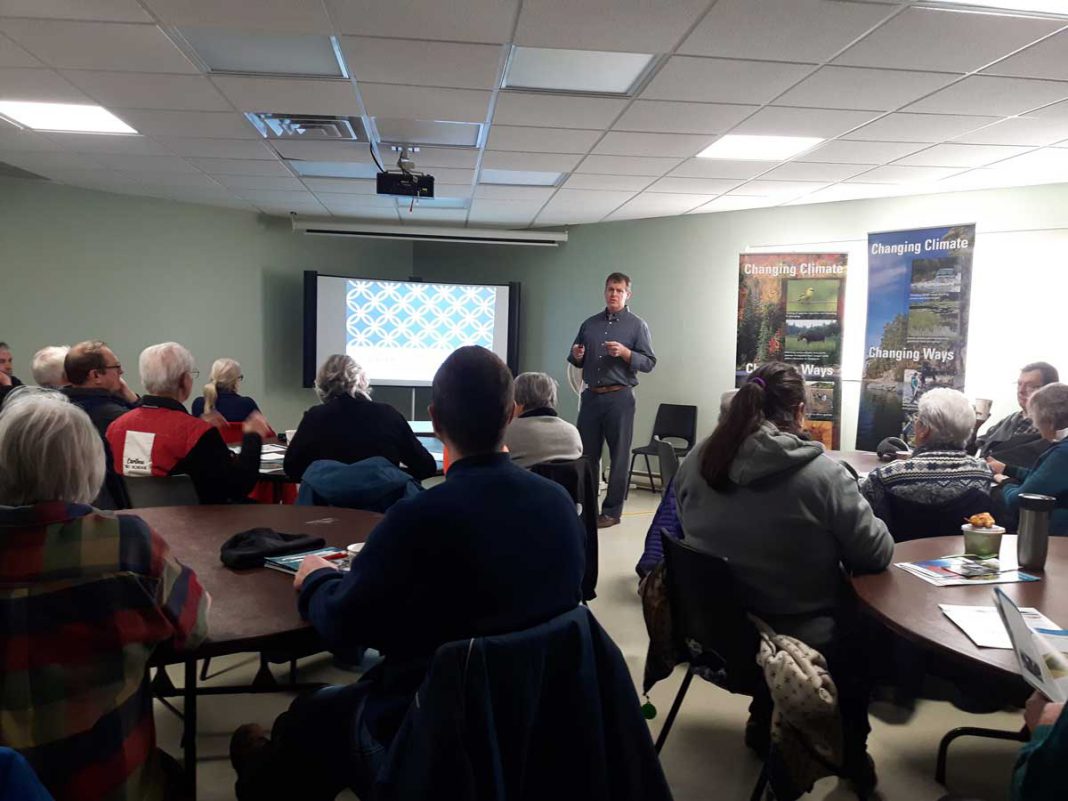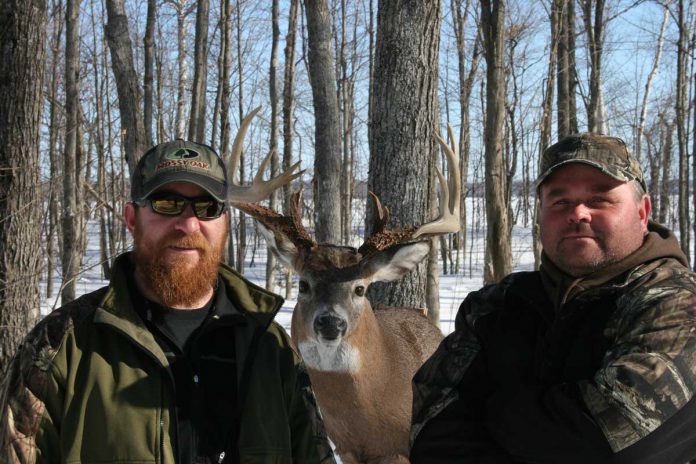MANITOULIN––Climate change and things associated with climate change made the list of top five threats to the global economy in the 2018 Global Risks Report at the World Economic Forum and have done so in every year since 2011. In 2013 the term climate change was changed to “failure of climate change mitigation and adaptation.”
“We’ve turned a corner,” noted Dr. Al Douglas, director of Ontario Centre for Climate Impact and Adaptation Resources (OCCIAR) in a climate change adaptation presentation coordinated by Manitoulin Streams at the Northeast Town recreation centre on Thursday, March 22.
OCCIAR develops and delivers climate change impact and adaptation resources and tools to communicate the science of climate change and to encourage the development and implementation of adaptation. In addition to his duties as director of OCCIAR, Mr. Douglas has owned and operated Hideaway Lodge in Kagawong since 2001. He feels a strong personal connection to the Island with its unique geology and geography and believes we must come together as a community to prepare for climate change by developing an Island-specific plan.
In October 2017 the Manitoulin Municipal Association (MMA) made a resolution to support OCCIAR’s proposed project for the development of partnerships to assess and manage the impact of climate change on Manitoulin Island.
Communities and agencies that take proactive steps to prepare for climate change will be more resilient to change. OCCIAR will undertake an Island Wide Risk Assessment with Manitoulin Streams as the delivery partner with participation from municipalities, First Nations, community members, business owners and seasonal residents. Environmental themes include agriculture, water, wetlands, aquaculture, tourism, fishing, wildlife and hunting to name a few. Community engagement and the sharing of traditional and local knowledge will contribute to a baseline, a starting point for adaptation activities.
We accept that climate change is occurring and that the warming of the planet is caused by the emission of greenhouse gases. “Now it’s time to focus on the effects, the impact, and adaption to these,” said Mr. Douglas.
“The extent of climate change in the future depends on what we do in the future plus the choices that we make now,” said Mr. Douglas. “We need to turn off emissions completely within the next two to three years to keep the temperature change to the 1.5° Celcius as per the Paris Agreement. Even if we shut off emissions completely today, climate change will continue for the next 40 to 50 years.” Unfortunately, we are currently tracking just below the 8.5° Celcius line.
There is a lot of research on the relationship between climate change and extreme weather conditions. “We can’t say that climate change causes extreme weather,” Mr. Douglas explained. “However, climate change creates the conditions in which these events are likely to occur more frequently and intensely.”
Projections for Ontario include more heat extremes, more frequent and intense extreme weather events, a decrease in snow and ice coverage, earlier ice break up and later freeze up dates. There is the potential for drought conditions and forest fires. Increases in flooding will case damage to property, soil erosion, degraded water quality, earlier peak flow in streams and rivers and decreased total flow in streams and rivers.
It is estimated that the economic fallout for the region will total $19.3 billion by 2050.
Mr. Douglas presented examples of climate change impacts in Ontario. Between 1948 and 2012, Western Ontario experienced a 30-40 percent increase in winter precipitation while Northeastern Ontario has seen a 10 percent decrease. “This is only a small part of the story,” he said. “How much precipitation falls, where it falls, the way the rain falls are bigger concerns.”
2013 water levels were extremely low but in 2018 the Great Lakes are again expected to reach above average levels. It is anticipated that Lake Superior will break the record high level set in the mid-1980s this year. The lake is already 10 cm away from the record and it has yet to receive any of the spring rain or snow melt.
Lake Huron’s temperature is increasing at a rate of greater than 0.85° Celcius per decade. The IISD Experimental Lakes Area has raised concerns about the survival of cold water fish species. For example, there could potentially be a 30-40 percent drop in suitable habitat for lake trout. We are likely to see more warm water species like smallmouth bass migrating north.
The health of our boreal forest is affected by climate change. Sport fish ranges have shifted north by 12 to 17 km per decade in the last 30 years. The northern leopard frog and the American toad emerge and call up to 37 days earlier in the spring.
There has also been an increase in invasive species found on Manitoulin Island. The lack of cold winter temperatures has allowed the pine beetle to move into Ontario. “A warming climate creates the conditions for invasive species to thrive and displace native species,” said Mr. Douglas.
“Moving forward, we want to gather different climate data for the Island to get a better picture of how climate change is occurring here,” he continued. “The process will start with data gathering, an assessment of current vulnerabilities, prioritizing future vulnerability and risks, implementation of adaptive actions, and monitoring progress. The survey of traditional and local knowledge will be the foundation of the process.”
“We’ll take all of this and map it out in terms of impacts,” said Mr. Douglas. “It’s not just a single event. Sometimes there are cascading events and we want to understand that a little better. We need to understand the linkages and interject adaptations at different points. We’re interested in determining barriers to adaptation, to determine how to maintain or increase resilience across the Island.”
Manitoulin Streams executive director Seija Deschenes wants community groups and cottagers to contribute their knowledge. “There is a lot of data out there,” she said. “There are frog surveys, bird surveys, cottage journals, fish and game clubs. All those little bits of information can be documented and useful. They are potentially very valuable.”
A survey to initiate the process will be distributed soon. Mr. Douglas anticipates the completion of the full risk assessment will take approximately 18 months.




